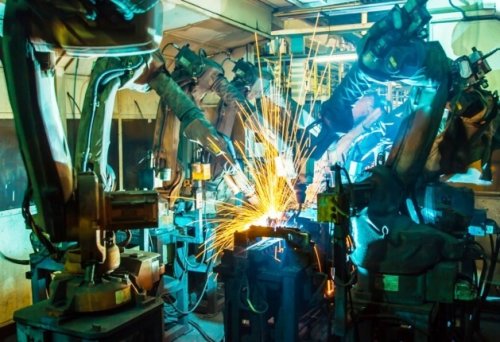Classification of industrial robots
An industrial robot is an automatic manipulation machine used in production processes and designed to perform motor and control actions (see — Application of industrial robots in just-in-time production).
Today, industrial robots of completely different types successfully serve in many industries, both for simple movement of objects and for performing complex technological operations, practically replacing a person in many areas, especially in those where high accuracy and quality of work performed , a large number of monotonous transactions, high volume, etc.
Due to the vastness of the field of industrial activity, there is a colossal number of different robots that differ from each other in terms of purpose, design, technical characteristics, areas of application, etc.
Regardless of its type, every industrial robot necessarily includes a manipulator and a programmable control unit, which actually sets all the necessary movements and control actions of the executive organs. Let's look at the standard classification of industrial robots.
The nature of the work performed
-
Manufacturing — performing manufacturing operations: welding, painting, bending, assembly, cutting, drilling, etc.
-
Auxiliary - carrying out lifting and transport functions: assembly, disassembly, laying, loading, unloading, etc.
-
Universal - performs both types of functions.
Load capacity
The lifting capacity of an industrial robot is defined as the maximum mass of an object of production that the robot is able to grasp and hold firmly without reducing its productivity. So, in terms of carrying capacity, industrial robots are divided into:
-
Super heavy — with a nominal load capacity of over 1000 kg.
-
Heavy — with a nominal load capacity from 200 to 1000 kg.
-
Medium — with a nominal load capacity from 10 to 200 kg.
-
Light - with a nominal load capacity of 1 to 10 kg.
-
Ultralight — with a nominal load capacity of up to 1 kg.
According to the installation method, industrial robots are:
-
Built-in — designed to serve a single machine;
-
Floor and suspended — more versatile, capable of large movements, they can work simultaneously with several machines, for example, for changing drills, positioning parts, etc.

Mobility or stability
Industrial robots are mobile and stationary. Movable ones are capable of transporting, orienting and coordinating movements, and immobile ones only for transporting and orienting movements.
Service area
The service area of an industrial robot is called the working space of the robot, in which the executive body (manipulator) is able to perform its intended functions without deteriorating the established characteristics.
Work area
The working area of an industrial robot is a space of a certain area in which the manipulator can perform work without violating the established characteristics. The working area is defined as the volume of space and can be from 0.01 cubic meters for high-precision robots and up to 10 cubic meters or even more (for mobile robots).
drive type
-
Electromechanical;
-
Hydraulic;
-
Pneumatic;
-
Combined.
Type of production
-
Transport works;
-
Warehouse work;
-
Automated control;
-
Installation;
-
Welding;
-
Drilling;
-
Casting;
-
Forging;
-
Heat treatment;
-
Painting;
-
Washes etc.
Linear and angular velocities
The linear speed of the industrial robot arm is usually 0.5 to 1 m/s, and the angular speed is 90 to 180 degrees/s.
Control type
According to the control method, industrial robots are:
-
With programmed control (numerical, cycle);
-
With adaptive control (by position, by contour).
Programming method:
-
analytical — drawing up a program;
-
trainee - the operator performs a sequence of actions, the robot remembers them.
Coordinate system view
The coordinate system of an industrial robot can be, depending on the purpose:
-
Rectangular;
-
Cylindrical;
-
Spherical;
-
Angle;
-
Combined.

Number of degrees of mobility
The number of degrees of mobility of an industrial robot is the total number of all available coordinate movements that the robot can perform with a grasped object relative to a fixed point of support (examples of fixed nodes: base, stand), without taking into account grasping and releasing movements on the bracket. So, according to the number of degrees of mobility, industrial robots are divided into:
-
with 2 degrees of mobility;
-
with 3 degrees of mobility;
-
with 4 degrees of mobility;
-
with more than 4 degrees of mobility.
Positioning error
The positioning error of an industrial robot is the permissible deviation of its manipulator from the position specified by the control program. Depending on the nature of the work, positioning errors are:
-
For rough work - from + -1 mm to + -5 mm;
-
For precision work -from + -0.1 mm to + -1 mm;
-
For highly precise work — up to + -0.1 mm.




